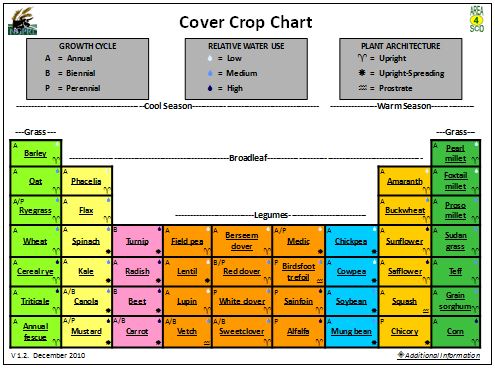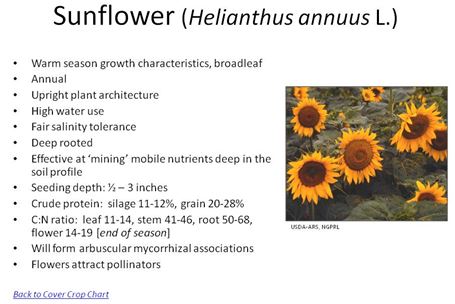 |
June 2013
|
June 2013 // Volume 51 // Number 3 // Tools of the Trade // v51-3tt7
Cover Crop Chart: An Intuitive Educational Resource for Extension Professionals
Abstract
Interest in cover crops by agricultural producers has increased the need for information regarding the suitability of crops for addressing different production and natural resource goals. To help address this need, staff at the USDA-ARS Northern Great Plains Research Laboratory developed a decision aid called the Cover Crop Chart (CCC). Visually analogous to the periodic table, the CCC includes information on 46 crop species within a free downloadable Portable Document Format (PDF) file. The CCC serves as a useful educational resource for agriculturalists learning about cover crops for the first time.
Introduction
Cover crops are increasingly used by agricultural producers to address a broad spectrum of ecosystem services affecting crop production and environmental quality. In response to increased demand for cover crop information, numerous resources have been developed through traditional and electronic media. Among traditional media, Managing Cover Crops Profitably (Clark, 2007) has served as a primary source of cover crop information since 1998. Numerous handbooks, fact sheets, Extension bulletins, and literature reviews have served to supplement information provided in the book, often with a regional focus (Sarrantonio, 1994), functional emphasis (Smart, Jeranyama, & Owens, 2004), or for specific crops (Björkman & Shail, 2010).
To date, traditional and electronic information sources typically organize the presentation of cover crops alphabetically or separately by crop type in an outline format (e.g., grasses, legumes, brassicas) (Baas, Mutch, & Ackroyd, 2011; University of California SARE Program, 2012). Such categorization, while convenient, may fall short in effectively presenting cover crop information by emphasizing a singular focus on select crops and, accordingly, fail to highlight potential complementary functions between crop types. Moreover, attributes associated with specific crops rely almost exclusively on written descriptions, while use of visual templates and descriptors are rare.
To supplement the growing demand for cover crop information and to address the presentation concerns outlined above, we sought to develop a decision aid using an intuitive, visual interface with an emphasis on cover crops relevant to producers in the U.S. Great Plains. The decision aid, hereafter referred to as the Cover Crop Chart (CCC), was the result of a serendipitous analogy with a common reference in chemistry (i.e., periodic table). This article describes the development of the CCC.
Approach
Cover crops adapted to the northern Great Plains were selected for inclusion in the CCC using an initial list compiled by USDA-NRCS North Dakota personnel and the Burleigh County Soil Conservation District. The list, which included 29 cover crops, was organized into four types: cool season grass, cool season broadleaf, warm season grass, and warm season broadleaf. Cover crops were recategorized into six groups: cool season grass, cool season broadleaf (non-legume), cool season broadleaf (legume), warm season broadleaf (legume), warm season broadleaf (non-legume), and warm season grass.
The periodic table, developed by Russian chemist Dimitri Mendeleev (1834-1907), is organized so that elements with identical valence electron configurations are placed in the same column (referred to as "groups") (Gordin, 2004). Using this framework, the list of crops were placed in columns and assigned a distinct background color within a PowerPoint slide to differentiate the six distinct crop types (Microsoft Corp., Redmond, WA). An additional 17 crops were selected from the literature based on their suitability as cover crops and placed in appropriate groups. The resulting figure was visually similar to a periodic table, and was designated the crop selection page (Figure 1).
Figure 1.
Cover Crop Selection Page of the Cover Crop Chart

To make the crop selection page more informative, supplemental information on growth cycle, relative water use, and plant architecture was added using icons in three corners of each crop box. Information on growth cycle was added to the upper left corner, with A, B, and P representing annual, biennial, and perennial crops. Broad categorization of certain crops necessitated using two crop growth icons (e.g., ryegrass, canola, mustard, vetch, red clover, sweetclover, and medic). Relative water use of select crops was assigned in the upper right corner using blue shaded raindrops for low, medium, and high categories following guidelines by Merrill, Tanaka, Krupinsky, Liebig, & Hanson (2007). Finally, a plant architecture icon was placed in the lower right corner of each crop box. Icons for upright, upright-spreading, and prostrate architecture were selected based on a review of photographs in books and Internet resources for crops at physiological maturity.
Individual crop pages were created to provide additional information for each crop. Relevant management information was compiled from multiple sources in the U.S. and Canada (e.g., relevant peer-reviewed journal articles, Midwest Cover Crops Council, USDA-SARE, Managing Cover Crops Profitably [Clark, 2007], and USDA-NRCS PLANTS database [USDA-NRCS, 2012]). Attributes presented on the crop selection page were also included as the first four bullets on each crop page (Figure 2). Photographs, either from the USDA-ARS Northern Great Plains Research Laboratory (NGPRL) archive or from Internet resources, were added to each page. Once completed, each crop page was connected to the respective crop box on the selection page via hyperlinks within PowerPoint. An "Additional Information" page was added to the PowerPoint for acknowledgements and disclaimers, and hyperlinked to the crop selection page.
Figure 2.
Individual Crop screen for Sunflower

Use, Availability, and Initial Feedback
The CCC is inherently easy to use. Using the crop selection page as a guide, individual crops are selected by clicking on the crop name, which directs users to additional information about the selected crop (via the hyperlink). Hyperlinked icons within each crop page then return users to the crop selection page, thereby facilitating comparisons of different crops.
The CCC is available for free download as a Portable Document Format (PDF) file (Adobe Systems Inc., San Jose, CA) on the USDA-ARS-NGPRL website (www.mandan.ars.usda.gov). Since release of version 1.1 (19 June 2010), the CCC has been downloaded over 1,400 times by users in 20 countries, was featured in two popular U.S. farming periodicals (Fee, 2011; Reichenberger, 2010), and has been used extensively in extension workshops throughout the Great Plains.
Conclusion
Increased use of cover crops by agricultural producers underscores the need for helpful decision aids to guide management decisions. The basic, foundational information provided in the CCC, along with its relative ease of use, make it an ideal educational resource for Extension professionals learning about cover crops for the first time.
Acknowledgments
We gratefully acknowledge valuable guidance and suggestions from producers and technicians in the Area IV Soil Conservation Districts of North Dakota and NRCS staff throughout North Dakota. Matt Flink, Jill Gunderson, Marvin Hatzenbuhler, Robert Kolberg, Heather Matthees-Dose, Steve Merrill, Delmer Schlenker, Eric Scholljegerdes, Cal Thorson, Lori Wanner, and Dawn Wetch provided helpful suggestions to improve the CCC.
Disclaimer
The USDA is an equal opportunity provider and employer. Mention of commercial products and organizations in this manuscript is solely to provide specific information. It does not constitute endorsement by USDA-ARS over other products and organizations not mentioned.
References
Baas, D. G., Mutch, D. R., & Ackroyd, V.J. (2011). A state-specific online cover crop decision tool for Midwest farmers. Journal of Extension [Online], 49(6) Article 6TOT8. Available at: http://www.joe.org/joe/2011december/tt8.php
Björkman, T., & Shail, J. W. (2010). Cornell cover crop guide for forage turnip and rape. Cornell University. 2pp. Ver. 1.100716.
Clark, A. (Ed.) (2007). Managing cover crops profitably. 3rd ed. USDA Sustainable Agriculture Network, Beltsville, MD.
Fee, R. (2011). Charting a course for cover crops. Successful Farming 109(4): S6(1).
Gordin, M.D . (2004). A well-ordered thing: Dmitri Mendeleev and the shadow of the periodic table. Basic Books, New York. 384 pp.
Merrill, S. D., Tanaka, D. L., Krupinsky, J. M., Liebig, M. A., & Hanson., J. D. (2007). Soil water depletion and recharge under ten crop species and applications to the principles of dynamic cropping systems. Agronomy Journal 99: 931-938.
Reichenberger, L. (2010). Dial-in a cover crop. The Furrow 115(8): 28-29.
Sarrantonio, M. (1994). Northeast cover crop handbook. Rodale Inst. Emmaus, PA. 118 pp.
Smart, A., Jeranyama, P., & Owens, V. (2004). The use of turnips for extending the grazing season. SDSU Coop. Ext. Service. Ext. Extra No. 2043. South Dakota State Univ., Brookings, SD.
University of California SARE Program. (2012). SAREP cover crops. Retrieved from: http://www.sarep.ucdavis.edu/database/covercrops
USDA-NRCS. (2012). PLANTS database. Retrieved from: http://plants.usda.gov/




